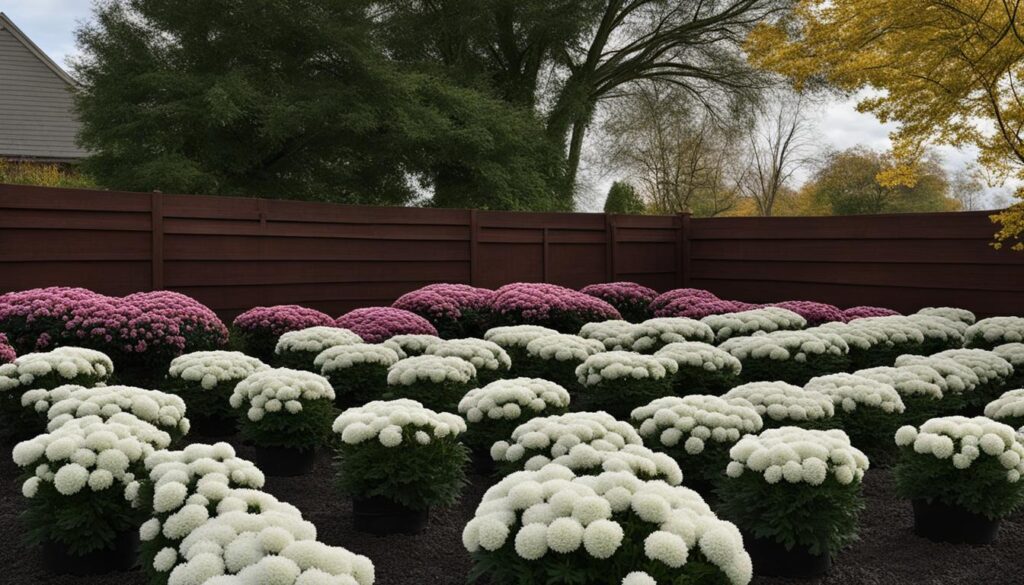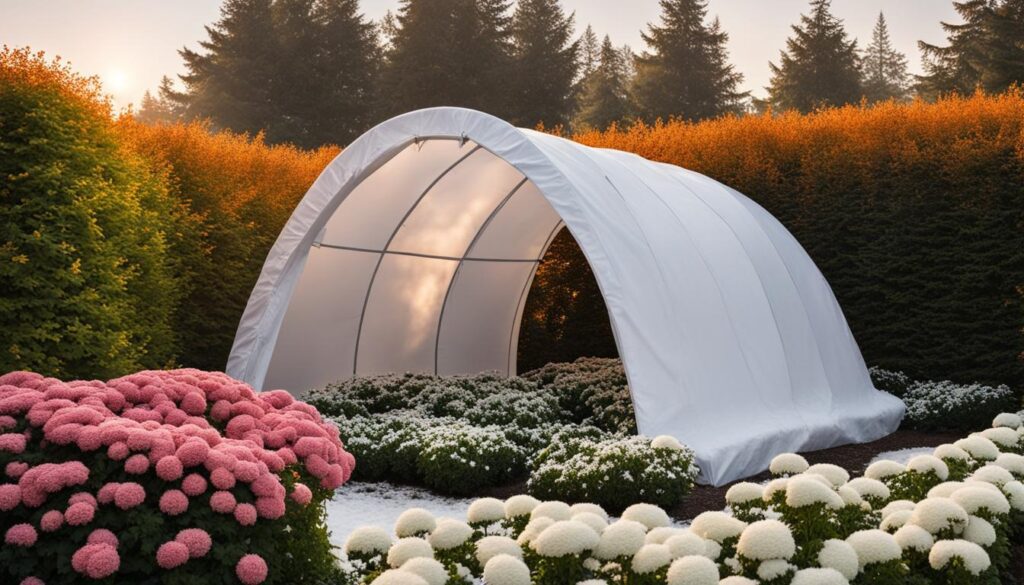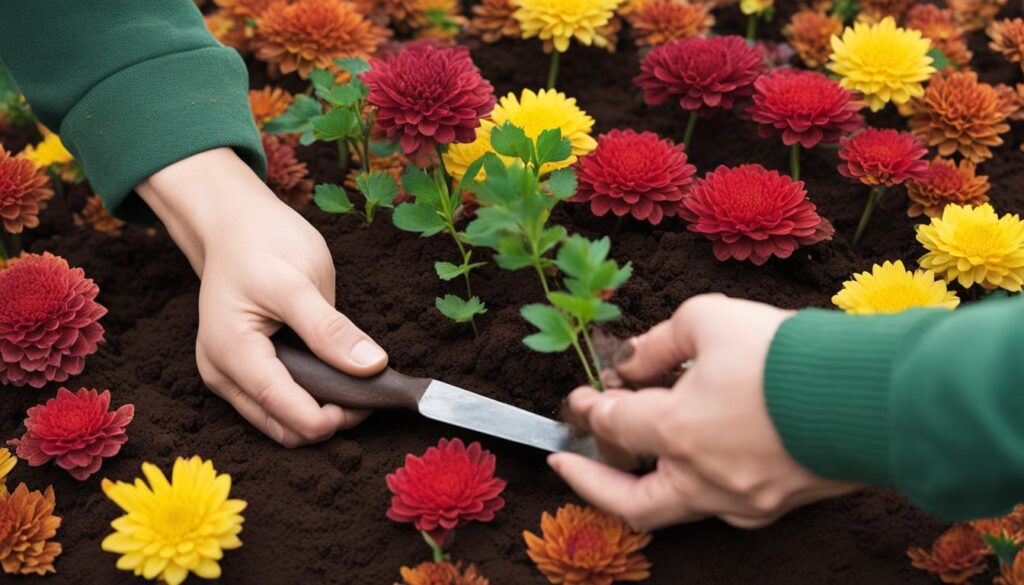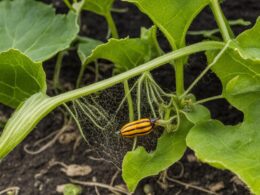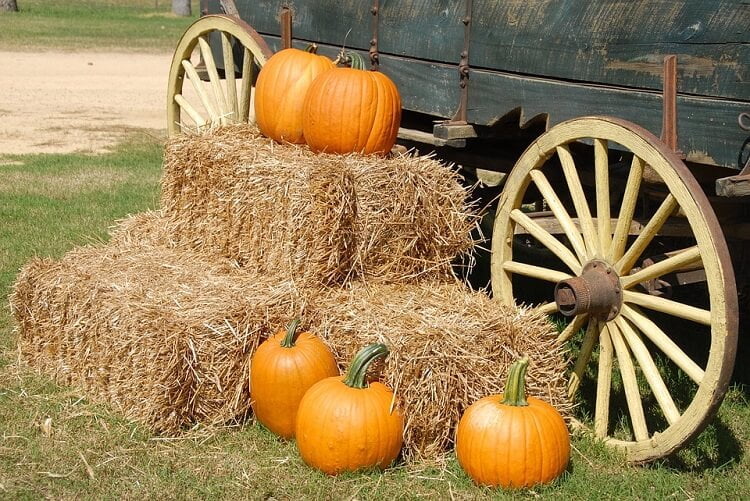Mums, also known as chrysanthemums, are beautiful autumn flowers that come in a variety of colors. While they are hardy and can tolerate cool temperatures, they are not immune to frost. Cold snaps can pose a threat to your mums and their delicate flowers, so it’s important to take steps to protect them.
Post Summary
- Frost can harm mums, so it’s crucial to take precautions to protect them.
- When selecting mums, choose healthy plants with closed blooms and green leaves.
- Use a sturdy container that is one-third larger than the root ball for optimal growth.
- Provide proper care by ensuring sufficient sunlight, maintaining soil moisture, and deadheading as needed.
- Understand mums’ cold acclimation process and their tolerance for frost.
Selecting Healthy Mums
When it comes to selecting mums for your garden, choosing healthy plants is essential for their prolonged blooming and overall vitality. Here are some tips to help you pick the healthiest mums:
- Look for plants that are not yet in full bloom. Closed or partially closed blooms indicate that the plant is in an earlier stage of its lifecycle. These mums will last longer when they do bloom, giving you more enjoyment throughout the season.
- Inspect the leaves of the mums. Opt for plants with green, vibrant leaves. Avoid any plants with yellowing or wilting leaves, as this could be a sign of stress or disease.
- Check the stems of the mums. Healthy mums have straight, sturdy stems. Avoid plants with bent or drooping stems, as they may not be as strong or resilient.
- Consider the overall appearance of the plant. Look for mums that have a well-rounded shape and abundant foliage. Avoid plants that appear leggy or sparse, as they may not produce as many blooms.
Remember, selecting healthy mums at the garden center is the first step in ensuring their prolonged blooming and overall longevity in your garden. Take your time to carefully inspect the plants and choose those that show signs of good health and vitality.
| Signs of Healthy Mums | Avoid |
|---|---|
| Closed or partially closed blooms | Plants in full bloom |
| Green, vibrant leaves | Yellowing or wilting leaves |
| Straight, sturdy stems | Bent or drooping stems |
| Well-rounded shape and abundant foliage | Leggy or sparse appearance |
By selecting healthy mums, you are setting the stage for a beautiful and thriving display of autumn flowers in your garden. Keep these tips in mind when you visit the garden center and enjoy the prolonged blooming of your mums throughout the season.
Choosing the Right Container
When it comes to selecting a container for your mums, it’s important to choose a sturdy one that can support their top-heavy nature. A sturdy container will help prevent them from tipping over in windy conditions and ensure they have a stable environment to grow in.
When repotting your mums, it’s crucial to consider the size of the root ball. Choose a container that is about one-third larger than the root ball to allow enough room for the roots to grow and spread. This will promote healthy growth and prevent the roots from becoming cramped.
Here is a table summarizing the key factors to consider when choosing the right container for your mums:
| Factor | Description |
|---|---|
| Sturdiness | Choose a container that can support the top-heavy nature of mums. |
| Size | The container should be about one-third larger than the root ball. |
By selecting a sturdy container and ensuring it is the right size for your mums, you are providing them with a suitable environment to thrive and grow.
General Care for Mums
Mums are beautiful flowers that require proper care to ensure their health and longevity. By following a few simple guidelines, you can keep your mums thriving and protect them from frost damage.
1. Sunlight
Mums thrive in sunny areas, so it’s important to place them in a location that receives at least six hours of sunlight per day. This will help promote healthy growth and vibrant blooms. If your mums are not getting enough sunlight, consider moving them to a sunnier spot or using artificial lighting.
2. Soil Moisture
Maintaining the right level of soil moisture is crucial for the health of your mums. While they require regular watering, it’s important to avoid overwatering, as excessive moisture can lead to root rot and other issues. Keep the soil moist but not waterlogged, and make sure the pots have proper drainage to prevent water from pooling.
3. Deadheading
Deadheading, or removing dead or faded flowers, is essential for keeping your mums looking fresh and encouraging new blooms. Regular deadheading promotes healthy growth and prevents the plant from wasting energy on producing seeds. Additionally, removing any dead or damaged leaves and stems will help prevent disease and pests from taking hold.
4. Frost Protection
Mums are vulnerable to frost damage, so it’s important to take precautions to protect them during cold snaps. If you’re expecting frost, move your mums indoors to a protected area, such as a garage or porch. If moving them indoors is not feasible, cover them with old towels or sheets to provide insulation. This will help prevent freezing and protect the delicate flowers.
By following these general care tips, you can ensure that your mums receive the sunlight, soil moisture, and protection they need to thrive. Remember to deadhead regularly and protect them from frost to keep your mums looking beautiful throughout the season.
Understanding Mums and Frost
Mums, also known as chrysanthemums, are hardy perennials that can withstand cooler temperatures. They have a natural resilience to frost, thanks to a process called cold acclimation. During this process, mums adjust to cold temperatures by producing more protective compounds and reducing water loss. This allows them to tolerate some frost without significant damage.
However, it’s important to note that while mums can tolerate some frost, they are not completely frost-resistant. A hard frost with extended periods of freezing temperatures can be detrimental to mums, potentially causing damage or even killing the plants. Therefore, it’s crucial to take precautions to protect your mums from severe frost.
Table:
| Frost Resistance | Temperature Threshold |
|---|---|
| Minimal Damage | 32°F (0°C) to 28°F (-2°C) |
| Moderate Damage | 28°F (-2°C) to 24°F (-4°C) |
| Severe Damage or Death | Below 24°F (-4°C) |
To protect your mums from frost, consider implementing insulation techniques. Mulch, such as straw or leaves, can regulate the soil temperature and moisture levels, providing some insulation. You can pile mulch around the base of the plants to help trap heat and keep the mums warm. Additionally, wrapping the plants with burlap or other breathable material can protect them from wind and cold elements.
Protecting Mums from Frost
When it comes to safeguarding your mums from frost, there are several effective techniques you can utilize. One method is to apply a light layer of mulch or straw around the base of the plants. This insulation helps to regulate soil temperature and keep the mums warm during cold snaps. Additionally, mulch helps retain moisture and prevents the soil from freezing, further protecting the root system.
Another approach is to plant mums in a sheltered location. Look for spots near buildings, fences, or trees that can provide natural protection from harsh winds and cold temperatures. These areas create a microclimate that can shield your mums from the brunt of frost damage. Ensuring the mums are placed in a sheltered location can make a significant difference in their survival.
“Applying a light layer of mulch around the base of the plants helps to regulate soil temperature and keep the mums warm during cold snaps.”
It’s important to note that while mulch and sheltered locations offer protection, it’s always a good idea to monitor the weather forecast regularly. If an imminent frost is predicted, you may want to take additional precautions, such as using frost blankets or covering the plants with old towels or sheets. These extra layers of insulation can provide an added level of frost protection for your mums.
| Frost Protection Techniques | Effectiveness |
|---|---|
| Mulch | Provides insulation, regulates soil temperature, and retains moisture |
| Sheltered Location | Offers natural protection from cold winds and frost |
| Frost Blankets or Covering | Extra layer of insulation for mums during imminent frost |
Conclusion
Protecting your mums from frost is essential to their survival and longevity. By using techniques such as mulching and selecting a sheltered location, you can significantly increase their chances of withstanding cold temperatures. Additionally, monitoring the weather forecast and taking extra precautions when frost is predicted can provide added peace of mind. Remember, taking the time to protect your mums from frost will ensure they continue to thrive and bring beauty to your garden.
Preparing Mums for Winter
As winter approaches, it is essential to prepare your mums for the cold weather to ensure their survival and health. There are two main approaches to winterizing mums: overwintering and winterizing in place. Both methods require attention to water retention and disease prevention to give your mums the best chance of thriving in the spring.
Overwintering Mums
If you choose to overwinter your mums, start by digging up the plants after the first frost has hit. Cut the stems down to about 6 inches to reduce the stress on the plant during storage. Find a cool and dark place, such as a basement or garage, to store the mums. Make sure the temperature is consistently between 35-45 degrees Fahrenheit (1-7 degrees Celsius) to ensure dormancy. Water the mums sparingly during storage, making sure the soil remains slightly moist but not wet. Before replanting in the spring, trim any dead or damaged parts, fertilize, and make sure the soil is well-drained.
Winterizing in Place
If you prefer to winterize your mums in place, start by cutting the stems down to about 6 inches after the first frost. Apply a layer of mulch around the base of the plants to insulate the roots and retain moisture. This layer of mulch also helps protect the plants from fluctuating temperatures and harsh winds. Water the mums regularly until the ground freezes to ensure proper hydration. Avoid fertilizing in the fall, as it can stimulate new growth that is vulnerable to cold damage. Remove any dead or diseased leaves to prevent disease and pest infestation during the winter months.
| Winterizing Method | Steps |
|---|---|
| Overwintering | – Dig up plants after the first frost – Cut stems down to 6 inches – Store in a cool, dark place at 35-45°F (1-7°C) – Water sparingly – Trim, fertilize, and replant in the spring |
| Winterizing in Place | – Cut stems down to 6 inches after the first frost – Apply a layer of mulch around the base of the plants – Water regularly until the ground freezes – Avoid fall fertilization – Remove dead or diseased leaves |
By following these winter preparation tips, you can ensure that your mums have the best chance of surviving the cold and flourishing in the following seasons. Remember to monitor their water retention, protect them from diseases, and provide appropriate conditions for their dormancy. With proper care and attention, your mums will reward you with vibrant blooms year after year.
Understanding Mums’ Blooming Cycle
Mums have a unique blooming cycle that requires specific care throughout the year. Understanding this cycle will help you maintain healthy and vibrant mums in your garden. Here is a breakdown of the different stages of their blooming cycle and the necessary actions for each:
- Spring Pruning: In spring, it is essential to prune any dead or damaged branches from your mums. This allows for fresh growth and promotes healthy blooms later in the season.
- Fertilizing and Watering: During spring and early summer, fertilize your mums to provide them with the nutrients they need for optimal growth. Regular watering is also crucial during this time to keep the soil moist but not waterlogged.
- Encouraging Blooming: As late summer or early fall approaches, mums start to bloom. To encourage more flowers, deadhead any spent blooms by cutting them back to the nearest set of leaves. This will redirect the plant’s energy into producing new blooms.
- Entering Dormancy: As winter approaches, mums enter a period of dormancy. This is when the plant’s growth slows down, and the leaves start to turn yellow. During this time, it is important to stop fertilizing and reduce watering to prevent the plant from rotting.
To protect your mums during the dormancy period and prepare them for winter, provide mulch protection. Apply a layer of mulch around the base of the plants, covering the root zone. This mulch will help insulate the soil, retain moisture, and protect the plant from extreme temperature fluctuations.
Mums’ Blooming Cycle and Care
| Blooming Cycle Stage | Actions to Take |
|---|---|
| Spring Pruning | Remove dead or damaged branches |
| Fertilizing and Watering | Apply fertilizer and water regularly |
| Encouraging Blooming | Deadhead spent blooms to promote more flowers |
| Entering Dormancy | Stop fertilizing, reduce watering, and provide mulch protection |
By following these essential practices for each stage of the blooming cycle, you can ensure that your mums stay healthy, vibrant, and ready to bloom year after year.
Image source: https://seo writing.ai/32_6.png
Insulating Mums from Frost
When it comes to protecting your mums from frost, proper insulation is key. Implementing effective insulation techniques can significantly increase their chances of survival. Let’s explore some methods that you can use to protect your mums from frost.
Using Mulch
Mulch is one of the most effective ways to insulate your mums from frost. Apply a layer of straw or leaves around the base of the plants to regulate soil temperature and moisture levels. This acts as a protective barrier, helping to keep the soil warm and preventing sudden temperature fluctuations that can harm the roots.
Wrapping with Burlap
In addition to mulch, you can also wrap your mums with burlap or other breathable materials to provide extra insulation. This helps protect the plants from cold winds and retains moisture, creating a microclimate that keeps the mums warm. Make sure to wrap the plants loosely to allow for proper airflow.
Choosing a Sheltered Location
Planting your mums in a sheltered location can provide natural protection from frost. Consider placing them near a building or under a tree, as this can help shield them from harsh winds and extreme temperatures. The surrounding structures act as a barrier, reducing the impact of frost on your mums.
By utilizing these insulation techniques, such as mulch, burlap, and strategic planting, you can safeguard your mums from frost damage. Remember to monitor weather conditions and take necessary precautions to ensure the longevity of your mums during cold spells.
Best Time to Plant Mums
Planting mums at the right time is crucial to ensure their successful growth and development. The timing of planting mums depends on whether you are opting for ground planting or using potted mums.
Ground Planting: For ground-planted mums, springtime is the ideal season to plant them. By planting in spring, mums have ample time to establish strong root systems before the winter months arrive. This allows them to develop a solid foundation and better withstand the cold temperatures.
Potted Mums: If you prefer potted mums, the best time to plant them is in the mid to late summer. This gives the plants enough time to acclimate to their new environment and establish their root systems before winter arrives. However, it’s important to note that potted mums should be brought indoors or provided with proper protection from frost during the winter months to prevent damage to the plants.
Comparison: Ground Planting vs. Potted Mums
| Ground Planting | Potted Mums |
|---|---|
| Plant in spring | Plant in mid to late summer |
| Allows for strong root system development before winter | Provides time for acclimation before winter |
| Less risk of damage from frost | Requires protection from frost |
By considering the best time to plant mums based on the planting method, you can give your mums the best chance of thriving and producing beautiful blooms. Whether you choose ground planting or potted mums, proper timing and care will lead to healthy, vibrant plants.
Conclusion
In conclusion, with the right care and precautions, mums can survive frost and thrive throughout the winter. By selecting healthy plants, providing appropriate containers, and giving general care such as proper sunlight and soil moisture, you can maintain healthy mums. Understanding their natural resilience to cold temperatures and taking steps to protect them from frost with mulch, insulation techniques, and strategic planting locations is crucial.
Winter care for mums involves preparing them for the colder months through overwintering or winterizing techniques. Regular watering until the ground freezes, avoidance of fall fertilization, and removal of dead or diseased leaves are essential to prevent diseases and pests. Additionally, understanding the mums’ blooming cycle and providing mulch protection during dormancy will help safeguard the plants from the cold.
By following these guidelines and maintaining proper winter care, you can ensure your mums survive frost and come back stronger and more beautiful in the spring. Take the necessary precautions to protect your mums throughout the winter, and enjoy the beauty of these resilient flowers year after year.
Can Mums Survive Frost If Kept Indoors?
Yes, mums as indoor plants can survive frost if kept indoors. Bringing them inside before the first frost hits will protect them from the cold temperatures. It’s important to place them in a sunny spot and water them regularly to keep them healthy and thriving throughout the winter months.
FAQ
Will frost hurt your mums?
Yes, a single frosty night can harm mums. It is essential to take precautions to protect your mums and ensure their longevity.
How do you select healthy mums?
When choosing mums at the garden center, opt for plants that are not in full bloom. Look for mums with green leaves and straight stems to ensure they are healthy.
What kind of container should you choose for mums?
A sturdy container that is approximately one-third larger than the root ball is essential for mums.
How do you care for mums?
Place mums in a location that receives at least six hours of sunlight per day. Keep the soil moist but avoid overwatering. Deadhead any dead or damaged flowers, leaves, and stems.
Do mums have natural resistance to frost?
Mums are hardy perennials that can withstand cooler temperatures and go through a process called cold acclimation. However, a hard frost with extended freezing temperatures can damage or kill mums.
How can you protect mums from frost?
Cover mums with a light layer of mulch or straw to provide insulation. Plant them in a sheltered location or wrap them with burlap for additional protection.
How do you prepare mums for winter?
You can either overwinter them by storing them in a cool, dark place or winterize them in place by cutting the stems and providing mulch protection. Water them regularly until the ground freezes and remove any dead or diseased leaves.
What is the blooming cycle of mums?
Prune dead or damaged branches in spring, fertilize the plants, and water them regularly. Mums bloom in late summer or early fall, and deadheading can encourage more flowers. As winter approaches, mums enter dormancy, and proper care is essential.
How do you insulate mums from frost?
Use mulch, such as straw or leaves, to regulate soil temperature and moisture levels. Pile the insulation materials around the base of the plants and wrap them with burlap or other breathable material for protection.
When is the best time to plant mums?
Ground-planted mums should be planted in spring, while potted mums can be planted in mid to late summer but require protection from frost during winter.
What is the key to mums surviving frost?
With proper care and precautions, mums can survive frost. Selecting healthy plants, providing general care, understanding their natural resilience, and protecting them from frost are all crucial factors.







